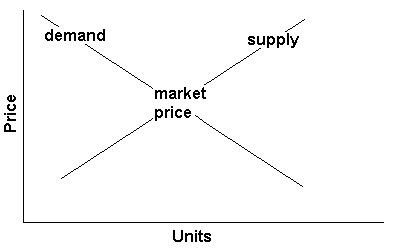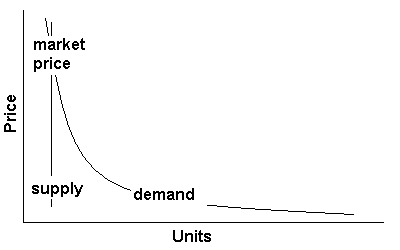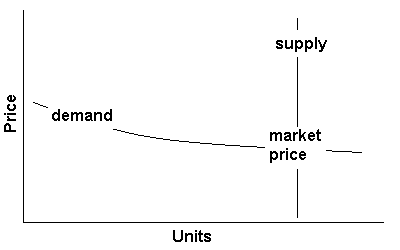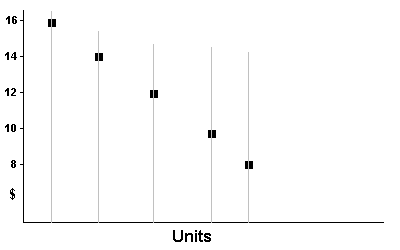Getting product pricing right
Setting the right price for a product has always been one of the most difficult hurdles for startups. Of course it only makes it worse that the pricing of your product is one of the most important decisions you as a businessowner will ever make. So how do you do it?
If your product happens to be webbased, here's an interesting idea. But first some basic economy on what the right price is.
According to classical economics the higher the price you charge for your product the less people will buy it: as prices rise demand decreases because less people are willing to pay the higher price, and supply rises since producers can get more for their wares. The market price is where the two meet. This is how a free market with perfect competition works. On a graph it looks like this:

Your goal as a businessowner is to maximise your operating income, which is the amount of money you have left when you have paid for your operating expenses. Operating expenses can be divided into variable and fixed operating expenses.
So your operating income can be defined like this:
Operating income = units x (price-variable expenses) - fixed expenses
Your fixed expenses are pay, rent, and other things you have to pay no matter how many customers you have. (Strictly speaking your fixed expenses will of course become variable as you grow since you need more people, bigger offices, etc.)
Your variable expenses are the expenses that can be related directly to how many units you sell. Support calls, server costs and delivery fall into this category. (again, strictly speaking most variable expenses are incremental: you either have one or two servers, not 1,4 servers)
Since you know, or can at least estimate, your variable and fixed expenses it is possible to calculate what your operating income is at different prices. The right price is of course the one where your operating income is as high as possible. If you had a graph of the demand curve for your product this would be easy: You could just find the price where (price - variable expenses) x units sold is at a maximum. Since you sell your product at the same price to all consumers your supply curve is vertical, No matter where the demand curve meets it the price is the same: everybody pays the same price. By changing the price you can slide your supply curve left or right. For instance, if your product costs $1 to produce you would rather sell 10 units at $5000 ($4990) than 2000 units at $3 ($4000). The problem is that you don't know how the demand curve slopes. Maybe your customers will start using your competitors cheaper product once you reach a certain price, maybe there's a psychological price barrier somewhere, or maybe a large percentage of your customers are willing to pay much more than you anticipate. You just don't know for sure.
If the demand curve goes like this the best option may be to sell expensive to a few customers that are willing to pay big bucks.

But if your demand curve goes like this you will be better off selling cheap, since none of your customers are willing to pay in buckets, but a large amount are willing to pay a decent amount.

Since there's really no way to know, except experience and looking at your competitors pricing most people and corporations just guess. Sometimes highly paid consultants are brought in to make a better guess. Large companies like Procter and Gamble have teams of experts committed to the game of guessing a price.
But for upstarts that sell their wares on the net there might be a better way.
Let's say you start a company that sells socks on the Internet. You have one product: a ten-pack of beautiful blue socks. Your competitors sell ten socks for ten bucks. so should you follow their price, make it cheaper or more expensive?
Webbased companies have done A/B split testing for many years to optimise their sites. The idea is that you show 50% of the users one page and 50% of the users another page and see which one performs best. Performance is usualy measured in terms of how many people buy something. Using this method you can continually test your site, try out new ideas, and micro-optimise it. Amazon is known for doing this.
What if you do split tests to optimise your price?
If you have a lower bound and an upper bound for the price of your ten socks you can hack a splittest together that will find the optimal price. The lower bound is the variable expense for the socks. The upper bound is a really high number. The program will start with a series of price points evenly distributed between the upper and lower bound. It will show a price of $10 to some customers, $8 to others, and maybe $20 to others still. Since you can capture how big a percentage of potential customers accept the price (by entering their credit card information and buying your socks) at different prices you will be able to micro-optimise the price. Using splittest technology and clever hacking you can actually test your way to the perfect price.
You start off with random values between the upper and lower bound, calculating your potential operating income for each price.
Let's say you have 1000 visitors that are shown five different prices randomly, and thus have different percentages of accepting the price - the higher price the less visitors will buy.
This will give you a rough demand curve with five pricing points: $8, $10, $12, $14 and $16. And from this you can see in which range the optimal price is. In the above example it is obvious that the optimal price point is somewhere around $14, since that is where the operating income is maximised. Now you can repeat your test in the $12 to $16 range, and iterate with smaller and smaller numbers until you find the perfect price.

I'm not oblivious to the potential problems of this approach, namely that in the test phase a number of customers will get wildly varying prices. There are a number of cases where this might be undesirable: It could affect your brand, customers might get angry hearing that they've paid twice as much as someone else, etc. But to get a statistically significant result you will probably not need to run that many visitors through the test. And I think it's worth it if you know that the price of your ten socks is the best it can be.
What do you think? Will it work? Is it insane?
And if you're thinking about actually building something like this shoot me an e-mail at max@maximise.dk. I'd love to consult :-)
If your product happens to be webbased, here's an interesting idea. But first some basic economy on what the right price is.
According to classical economics the higher the price you charge for your product the less people will buy it: as prices rise demand decreases because less people are willing to pay the higher price, and supply rises since producers can get more for their wares. The market price is where the two meet. This is how a free market with perfect competition works. On a graph it looks like this:
Your goal as a businessowner is to maximise your operating income, which is the amount of money you have left when you have paid for your operating expenses. Operating expenses can be divided into variable and fixed operating expenses.
So your operating income can be defined like this:
Operating income = units x (price-variable expenses) - fixed expenses
Your fixed expenses are pay, rent, and other things you have to pay no matter how many customers you have. (Strictly speaking your fixed expenses will of course become variable as you grow since you need more people, bigger offices, etc.)
Your variable expenses are the expenses that can be related directly to how many units you sell. Support calls, server costs and delivery fall into this category. (again, strictly speaking most variable expenses are incremental: you either have one or two servers, not 1,4 servers)
Since you know, or can at least estimate, your variable and fixed expenses it is possible to calculate what your operating income is at different prices. The right price is of course the one where your operating income is as high as possible. If you had a graph of the demand curve for your product this would be easy: You could just find the price where (price - variable expenses) x units sold is at a maximum. Since you sell your product at the same price to all consumers your supply curve is vertical, No matter where the demand curve meets it the price is the same: everybody pays the same price. By changing the price you can slide your supply curve left or right. For instance, if your product costs $1 to produce you would rather sell 10 units at $5000 ($4990) than 2000 units at $3 ($4000). The problem is that you don't know how the demand curve slopes. Maybe your customers will start using your competitors cheaper product once you reach a certain price, maybe there's a psychological price barrier somewhere, or maybe a large percentage of your customers are willing to pay much more than you anticipate. You just don't know for sure.
If the demand curve goes like this the best option may be to sell expensive to a few customers that are willing to pay big bucks.
But if your demand curve goes like this you will be better off selling cheap, since none of your customers are willing to pay in buckets, but a large amount are willing to pay a decent amount.
Since there's really no way to know, except experience and looking at your competitors pricing most people and corporations just guess. Sometimes highly paid consultants are brought in to make a better guess. Large companies like Procter and Gamble have teams of experts committed to the game of guessing a price.
But for upstarts that sell their wares on the net there might be a better way.
Let's say you start a company that sells socks on the Internet. You have one product: a ten-pack of beautiful blue socks. Your competitors sell ten socks for ten bucks. so should you follow their price, make it cheaper or more expensive?
Webbased companies have done A/B split testing for many years to optimise their sites. The idea is that you show 50% of the users one page and 50% of the users another page and see which one performs best. Performance is usualy measured in terms of how many people buy something. Using this method you can continually test your site, try out new ideas, and micro-optimise it. Amazon is known for doing this.
What if you do split tests to optimise your price?
If you have a lower bound and an upper bound for the price of your ten socks you can hack a splittest together that will find the optimal price. The lower bound is the variable expense for the socks. The upper bound is a really high number. The program will start with a series of price points evenly distributed between the upper and lower bound. It will show a price of $10 to some customers, $8 to others, and maybe $20 to others still. Since you can capture how big a percentage of potential customers accept the price (by entering their credit card information and buying your socks) at different prices you will be able to micro-optimise the price. Using splittest technology and clever hacking you can actually test your way to the perfect price.
You start off with random values between the upper and lower bound, calculating your potential operating income for each price.
Let's say you have 1000 visitors that are shown five different prices randomly, and thus have different percentages of accepting the price - the higher price the less visitors will buy.
| Price: | $8 | $10 | $12 | $14 | $16 |
| Percent that buy socks: | 30% | 25% | 22% | 19% | 14% |
| Turnover for 1000 visitors: | $2400 | $2500 | $2640 | $2660 | $2240 |
| Variable cost for 1000 visitors: | $300 | $250 | $220 | $190 | $140 |
| Fixed cost: | $1000 | $1000 | $1000 | $1000 | $1000 |
| Potential operating income for 1000 visitors: | $1100 | $1250 | $1420 | $1470 | $1100 |
This will give you a rough demand curve with five pricing points: $8, $10, $12, $14 and $16. And from this you can see in which range the optimal price is. In the above example it is obvious that the optimal price point is somewhere around $14, since that is where the operating income is maximised. Now you can repeat your test in the $12 to $16 range, and iterate with smaller and smaller numbers until you find the perfect price.
I'm not oblivious to the potential problems of this approach, namely that in the test phase a number of customers will get wildly varying prices. There are a number of cases where this might be undesirable: It could affect your brand, customers might get angry hearing that they've paid twice as much as someone else, etc. But to get a statistically significant result you will probably not need to run that many visitors through the test. And I think it's worth it if you know that the price of your ten socks is the best it can be.
What do you think? Will it work? Is it insane?
And if you're thinking about actually building something like this shoot me an e-mail at max@maximise.dk. I'd love to consult :-)



0 Comments:
Post a Comment
<< Home